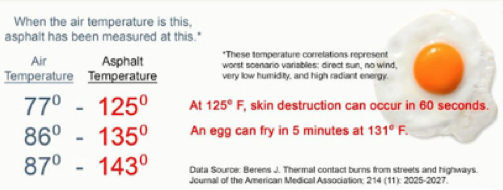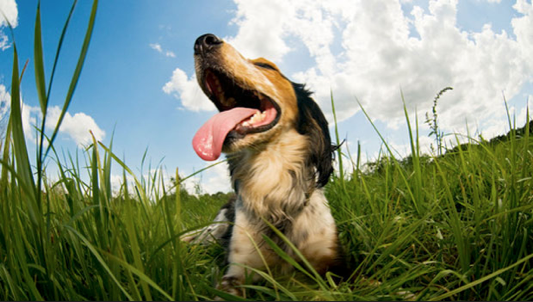Heatstroke in Dogs – A Practical Guide By Colin’s Pack
This guide is intended to be a very practical guide based on my personal experience of over 7 years of hiking packs of dogs. This is, in no way, intended to be a comprehensive treatise on heatstroke in dogs. Before applying any of this knowledge, please consult with a veterinarian. Neither Colin’s Pack Inc., Colin West, nor any Colin’s Pack employees will not be held liable for any harm, damage, or death that results from following this guide.
A quick introduction and story of a close-call:
My name is Colin West, and I’ve been on over 2500 hikes in the Santa Monica Mountains since I founded Colin’s Pack in late 2010. I’ve had one very close call with heatstroke which occurred in 2014; a Bernese Mountain Dog ended up in the hospital with a 50% chance of living. Luckily the dog survived, and the owners graciously forgave me, but there could have very easily been a different outcome. After acting extremely lethargic after our hike, the owner decided to take her dog to the vet, where she heard the news that her dog might not survive. That is a call you do not want to have to receive; knowing that you were responsible for the possible death of a dog that was entrusted to your care. Luckily, after much stress and prayer, the dog survived, after about a week in the hospital and roughly $3500 in vet bills that I happily paid. Luckily the owners graciously forgave me, and their dog lived. Lesson learned.

That incident made me hyper-vigilant from then on, and it also made me realize that I had probably had more close calls than I realized, but had just been lucky up until that point.
There were warning signs that day that I did not pay attention to; the high humidity, the breed of the dog (a cold weather, thick-coated dog), the dog’s excess body weight, the fact that this dog did not know when to slow down, and also, the diarrhea she had before I dropped her off.
This guide is in no way intended to be a comprehensive guide, but rather, a very practical guide based on my experience, with the intention of helping others avoid a situation like the one I experienced.
Some relevant information:
Heatstroke occurs when a dog is unable to keep cool, and his body temperature rises to a dangerous level. According to the American Kennel Club, the typical body temperature of a dog is between 101-102.5 degrees Fahrenheit, and anything above 104 degrees is considered high. If your dog’s body temperature reaches 109 degrees, it can be dead in minutes. The damage to the body is extensive, affecting almost all cells and organs. I won’t get into the specifics in this article, but you can read more about that here: http://www.vetfolio.com/emergency-medicine/heatstroke-in-dogs
An ounce of prevention is worth a pound of cure.
Staying vigilant and taking precautionary steps to avoid heatstroke is much easier than dealing with a dog that is already overheating; if a dog is showing signs of heatstroke, it could already be too late to save his life. Having heatstroke once can also increase the likelihood of having it again. I personally never want any dog to get anywhere near a deadly body temperature level, and like with any negative occurrence, being on the lookout in advance can help prevent the problem.
Factors to keep in mind in advance:
- -High temperatures (of course)
- -Humidity (high humidity inhibits a the evaporative cooling off of a dog’s lungs when they pant; their primary method of cooling down)
- -The color or your dog’s coat (the darker the coat, the more heat it will absorb from the sun)
- -The thickness of the coat (the thicker, the more heat it can trap inside of your dog)
- -Weight of the dog (overweight dogs can overheat more easily)
- -The practical intelligence of the dog (some dogs do not know to stop playing or exercising when too hot, some do not know to go to the shade to cool down, etc.)
- Older or unhealthy dogs
- -Brachiocephalic dogs (short nosed dogs, such as Bulldogs, have trouble panting effectively which can make it difficult to cool themselves down.)
- -The fact that the air temperature can be much higher as you get closer to the ground, making your dog much hotter than you while walking/hiking in the same weather.
- -Hot ground (the heat from the ground can flow directly into the pads of your dog’s feet, adding another influx of heat to their body)

If you have any combination of the factors above, the dog is at an even higher risk of overheating.
Add all of these things together, and it’s easy to understand how a dog could be getting much hotter than you in the same outdoor conditions. Please keep in mind – it isn’t always that obvious which dogs will be more likely to overheat. Sometimes a young and playful dog that does not know when to stop might be more at risk of overheating than an older more experienced black dog who is overweight. ALL dogs are susceptible to overheating, so I would recommend always paying close attention regardless of the breed, age, weight, coat, etc to get an idea of how your dog handles high temperatures.
Signs of overheating
- Heavy panting
- Excessive thirst
- Glazed eyes
- Vomiting and bloody diarrhea
- Bright or dark red tongue, gums
- Staggering
- Elevated body temperature (104ºF and up)
- Weakness, collapse
- Increased pulse and heartbeat
- Seizures
- Excessive drooling
- Unconsciousness

Also, and this is very important; what is the feeling you get when looking at your dog? You are connected to your dog, and if your dog feels stressed you, he probably is. Dogs that are getting too hot will likely have a stressful look/feel to them; they may be pacing, and in general, have an air of anxiety about them. Throwing up and having diarrhea is a very bad sign if your dog already looks stressed; it is a dog’s body’s emergency attempt to get rid of the heat that is stored in the liquid. If your dog has already reached this point, I would first cool her down quickly, and then get her to a veterinarian as quickly as possible for laboratory tests.
What to do if you missed the signs, and your dog is already too hot:
It’s extremely important to never let an overheated dog into a confined space, such as a car or crate, until you have cooled them down sufficiently. Pay close attention to their stress level, and make sure you bring it down sufficiently. If your dog was too hot for too long, or you are questioning whether they may have had heatstroke, its best to take them to the vet in my opinion; heatstroke can be so insidious, and it’s better to be safe than sorry in this case.
STEP 1: Cool your dog down–use water if possible
-Probably the best way to do this is to Use Water. Water has a very high specific heat. In other words, it has the ability to absorb a relatively large amount of heat, and can also do so very quickly. If you can let your dog jump into a swimming pool, or other cool body of water, this will allow them to cool down very quickly. You can also pour water over their body, and rub it into their coat. Evaporation will cool them off very quickly, and placing them in a place with high airflow, like a windy mountaintop or in front of a fan, will also speed the cooling process. Be careful not to use ice or ice water, as this can make your dog’s blood vessels constrict, and actually slow their ability to cool themselves down. If your dog is a shorthaired dog, I would definitely recommend the Ruffwear “Swamp Cooler,” which is very effective for shorthaired dogs. https://ruffwear.com/products/swamp-cooler,
STEP 2: Take to the vet.
Take your dog to the veterinarian if you are questioning whether your dog had heatstroke. Your veterinarian can take blood and urine tests to determine if there has been any damage to the organs and blood. If so, they can administer IV fluids, an oxygen mask, and monitor the functioning of your dog closely until they recover.
Conclusion:
Heatstroke should be taken very seriously. There’s nothing worse than knowing that a dog is in the hospital and could potentially die because of something that could have been prevented. I would always recommend erring on the side of caution, and having a lazy but safe day as opposed to overextending your dog. I find that most dogs tend to like to take it easy in the heat anyway, so let them!
I hope this article was helpful, and I hope you all have a safe and happy summer!
Colin West


